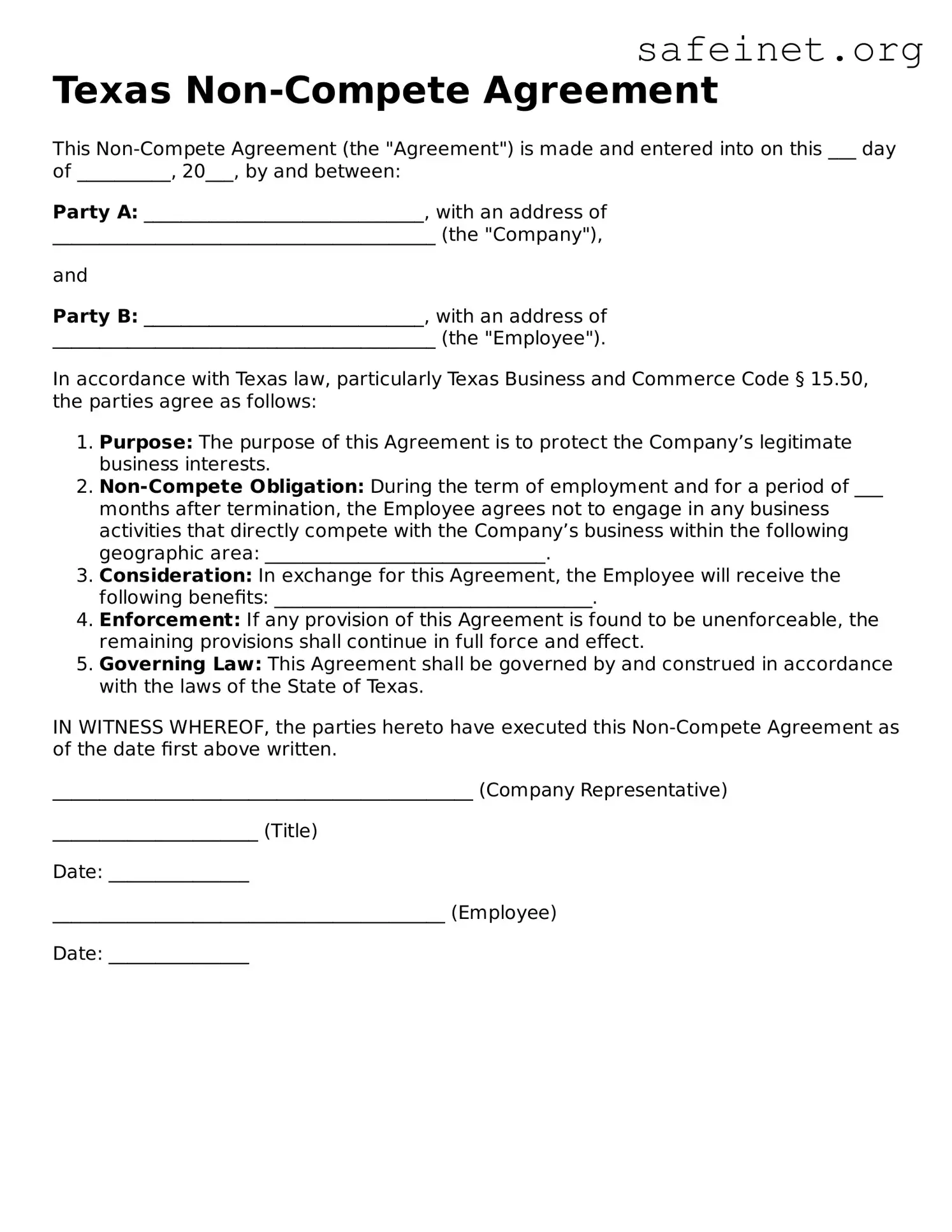The Texas Non-Compete Agreement resembles the Employment Agreement in that both documents establish the terms of the relationship between an employer and an employee. An Employment Agreement outlines job responsibilities, compensation, and the duration of employment. Similarly, a Non-Compete Agreement specifies what limitations an employee faces after leaving a job, often to protect trade secrets or sensitive business information. Both documents serve to clarify expectations and protect the interests of the employer.
Another document that shares similarities with the Texas Non-Compete Agreement is the Confidentiality Agreement, or Non-Disclosure Agreement (NDA). This agreement focuses on protecting sensitive information shared between parties. While a Non-Compete Agreement restricts an employee’s future employment in competing businesses, a Confidentiality Agreement prevents individuals from disclosing proprietary information. Both play vital roles in safeguarding a company's assets and maintaining its competitive edge.
A Partnership Agreement is also somewhat akin to a Non-Compete Agreement. It governs the relationships among business partners, detailing roles, responsibilities, and profit-sharing arrangements. In some cases, Partnership Agreements may include non-compete clauses to restrict partners from engaging with competitors after leaving the partnership. This ensures that all partners remain committed to the success of the business, similar to how Non-Compete Agreements protect an employer’s interests.
The Sale of Business Agreement shares elements with a Non-Compete Agreement, particularly concerning the interests of the buyer and seller. When a business is sold, the seller may agree not to start a competing business for a specified period to ensure the buyer can thrive without immediate competition. This arrangement mirrors the restrictions found in Non-Compete Agreements, emphasizing the need for a fair transition of business interests.
A Franchise Agreement bears resemblance to the Texas Non-Compete Agreement in its terms of operating a business under an established brand. Franchise Agreements often contain provisions that restrict franchisees from competing against the franchisor once the agreement ends. Like Non-Compete Agreements, these provisions aim to sustain brand integrity and protect the franchisor’s market share from future competition.
Independent Contractor Agreements can also reflect similarities to Non-Compete Agreements by including clauses that limit a contractor’s ability to work with competitors during and after the contract period. These agreements outline the nature of the contractor’s services while potentially restricting them from engaging in similar work with competitors, thus protecting the client’s business interests in ways akin to a Non-Compete Agreement.
Licensing Agreements may share certain aspects with Non-Compete Agreements, particularly in their approach to trade secrets and proprietary technology. A Licensing Agreement allows one party to use the intellectual property of another, and often contains clauses that prevent the licensee from using that information to create competing products. This protective measure echoes the intent of Non-Compete Agreements aimed at safeguarding business interests and encouraging fair competition.
In some contexts, an Assignment Agreement can relate closely to a Non-Compete Agreement. This document transfers rights from one party to another, often including provisions that restrict the assignee’s ability to engage in similar ventures. Such restrictions help protect the assignor’s rights and further underpin the protective nature of Non-Compete Agreements in the professional landscape.
A Technology Transfer Agreement may also have parallels with Non-Compete Agreements, especially in fields that rely heavily on innovation and proprietary technology. This document governs the terms under which technology is shared between parties, typically including clauses that restrict the receiving party from using this technology to develop competing products. This alignment with the goals of a Non-Compete Agreement underscores the necessity of protecting intellectual property in competitive industries.
Lastly, a Shareholder Agreement can be compared to a Non-Compete Agreement since it often contains clauses that limit shareholders from engaging in competing ventures once they exit the company. By outlining these restrictions, a Shareholder Agreement seeks to protect the interests of remaining shareholders and ensure the stability of the business, firmly aligning with the fundamental objectives of Non-Compete Agreements.
